Energy Transfer and Cross-Relaxation Induced Efficient 2.78 μm Emission in Er3+/Tm3+: PbF2 mid-Infrared Laser Crystal
Abstract
:1. Introduction
2. Experimental Section
3. Calculation Method
4. Results and Discussion
4.1. Crystal Structure Analysis
4.2. First-Principles Calculations
4.3. Absorption Spectroscopy
4.4. Emission Spectra and Emission Cross-Sections
4.5. Energy Transfer Mechanism between Tm3+ and Er3+ Ions
4.6. Fluorescence Decay Curves and Fluorescence Lifetimes
5. Conclusions
Author Contributions
Funding
Institutional Review Board Statement
Informed Consent Statement
Data Availability Statement
Conflicts of Interest
References
- Popov, A.; Sherstnev, V.; Yakovlev, Y.P.; Baranov, A.; Alibert, C. Powerful Mid-Infrared Light Emitting Diodes for Pollution Monitoring. Electron. Lett. 1997, 33, 86–88. [Google Scholar] [CrossRef]
- Bekman, H.T.; Van Den Heuvel, J.; Van Putten, F.; Schleijpen, R. Development of a Mid-Infrared Laser for Study of Infrared Countermeasures Techniques. In Proceedings of the Technologies for Optical Countermeasures, London, UK, 26–27 October 2004; Volume 5615, pp. 27–38. [Google Scholar]
- Hu, T.; Dong, B.; Luo, X.; Liow, T.Y.; Song, J.; Lee, C.; Lo, G.Q. Silicon Photonic Platforms for Mid-Infrared Applications. Photonics Res. 2017, 5, 417–430. [Google Scholar] [CrossRef] [Green Version]
- Walsh, B.M.; Lee, H.R.; Barnes, N.P. Mid Infrared Lasers for Remote Sensing Applications. J. Lumin. 2016, 169, 400–405. [Google Scholar] [CrossRef]
- Urich, A.; Maier, R.R.J.; Yu, F.; Knight, J.C.; Hand, D.P. Silica Hollow Core Microstructured Fibres for Mid-Infrared Surgical Applications. J. Non-Cryst. Solids 2013, 377, 236–239. [Google Scholar] [CrossRef] [Green Version]
- Godard, A. Infrared (2–12 Μm) Solid-State Laser Sources: A Review. Comptes Rendus Phys. 2007, 8, 1100–1128. [Google Scholar] [CrossRef]
- Vodopyanov, K.; Ganikhanov, F.; Maffetone, J.; Zwieback, I.; Ruderman, W. ZnGeP2 Optical Parametric Oscillator with 3.8–12.4-µm Tunability. Opt. Lett. 2000, 25, 841–843. [Google Scholar] [CrossRef]
- Zhang, T.; Feng, G.; Zhang, H.; Yang, X.; Dai, S.; Zhou, S. 2.78 μm Passively Q-Switched Er3+-Doped Zblan Fiber Laser Based on PLD-Fe2+: Znse Film. Laser Phys. Lett. 2016, 13, 075102. [Google Scholar] [CrossRef]
- Zhang, C.; Hao, Q.; Zu, Y.; Zong, M.; Guo, J.; Zhang, F.; Ge, Y.; Liu, J. Graphdiyne Saturable Absorber for Passively Q-Switched Ho3+-Doped Laser. Nanomaterials 2020, 10, 1848. [Google Scholar] [CrossRef]
- Pajewski, L.; Sójka, L.; Lamrini, S.; Benson, T.M.; Seddon, A.B.; Sujecki, S. Gain-Switched Dy3+: Zblan Fiber Laser Operating around 3 μm. J. Phys. Photonics 2019, 2, 014003. [Google Scholar] [CrossRef]
- Wu, Z.; Sun, D.; Wang, S.; Luo, J.; Li, X.; Huang, L.; Hu, A.; Tang, Y.; Guo, Q. Performance of a 967 nm Cw Diode End-Pumped Er: GSGG Laser at 2.79 μm. Laser Phys. 2013, 23, 055801. [Google Scholar] [CrossRef] [Green Version]
- Arbabzadah, E.; Chard, S.; Amrania, H.; Phillips, C.; Damzen, M. Comparison of a Diode Pumped Er: YSGG and Er: YAG Laser in the Bounce Geometry at the 3 μm Transition. Opt. Express 2011, 19, 25860–25865. [Google Scholar] [CrossRef]
- Kawase, H.; Yasuhara, R. 2.92-µm High-Efficiency Continuous-Wave Laser Operation of Diode-Pumped Er: YAP Crystal at Room Temperature. Opt. Express 2019, 27, 12213–12220. [Google Scholar] [CrossRef]
- Li, T.; Beil, K.; Kränkel, C.; Huber, G. Efficient High-Power Continuous Wave Er: Lu2O3 Laser at 2.85 μm. Opt. Lett. 2012, 37, 2568–2570. [Google Scholar] [CrossRef] [PubMed]
- Hou, W.; Zhao, H.; Qin, Z.; Liu, J.; Wang, D.; Xue, Y.; Wang, Q.; Xie, G.; Xu, X.; Xu, J. Spectroscopic and Continuous-Wave Laser Properties of Er: GdScO3 Crystal at 2.7 µm. Opt. Mater. Express 2020, 10, 2730–2737. [Google Scholar] [CrossRef]
- Ma, W.; Qian, X.; Wang, J.; Liu, J.; Fan, X.; Liu, J.; Su, L.; Xu, J. Highly Efficient Dual-Wavelength Mid-Infrared Cw Laser in Diode End-Pumped Er: SrF2 Single Crystals. Sci. Rep. 2016, 6, 1–7. [Google Scholar]
- Bandiello, E.; Sánchez-Martín, J.; Errandonea, D.; Bettinelli, M. Pressure effects on the optical properties of NdVO4. Crystals 2019, 9, 237. [Google Scholar] [CrossRef] [Green Version]
- Botella, P.; Enrichi, F.; Vomiero, A.; Munõz-Santiuste, J.E.; Garg, A.B.; Arvind, A.; Manjón, F.J.; Segura, A.; Errandonea, D. Investigation on the Luminescence Properties of InMO4 (M = V5+, Nb5+, Ta5+) Crystals Doped with Tb3+ or Yb3+ Rare Earth Ions. ACS Omega 2020, 5, 2148–2158. [Google Scholar] [CrossRef] [PubMed] [Green Version]
- Zhang, P.; Chen, Z.; Hang, Y.; Li, Z.; Yin, H.; Zhu, S.; Fu, S.; Li, A. Enhanced 2.7 μm Mid-Infrared Emissions of Er3+ Via Pr3+ Deactivation and Yb3+ Sensitization in LiNbO3 Crystal. Opt. Express 2016, 24, 25202–25210. [Google Scholar] [CrossRef]
- Li, S.; Zhang, L.; Zhang, P.; Hang, Y. Nd3+ as Effective Sensitization and Deactivation Ions in Nd, Er: LaF3 Crystal for the 2.7 μm Lasers. J. Alloy. Compd. 2020, 827, 154268. [Google Scholar] [CrossRef]
- Li, M.; Liu, X.; Guo, Y.; Hao, W.; Hu, L.; Zhang, J. ~2 μm Fluorescence Radiative Dynamics and Energy Transfer between Er3+ and Tm3+ Ions in Silicate Glass. Mater. Res. Bull. 2014, 51, 263–270. [Google Scholar] [CrossRef]
- Sandrock, T.; Diening, A.; Huber, G. Laser Emission of Erbium-Doped Fluoride Bulk Glasses in the Spectral Range from 2.7 to 2.8 μm. Opt. Lett. 1999, 24, 382–384. [Google Scholar] [CrossRef] [PubMed]
- Wang, J.; Cheng, T.; Wang, L.; Yang, J.; Sun, D.; Yin, S.; Wu, X.; Jiang, H. Compensation of Strong Thermal Lensing in an LD Side-Pumped High-Power Er: YSGG Laser. Laser Phys. Lett. 2015, 12, 105004. [Google Scholar] [CrossRef]
- Gao, S.; Chen, T.; Hu, M.; Xu, S.; Xiong, Y.; Cheng, S.; Zhang, W.; Wang, Y.; Yang, W. Effects of Er3+ Concentration on the Optical Properties of Er3+: SrGdGa3O7 Single Crystals. Opt. Mater. 2019, 98, 109502. [Google Scholar] [CrossRef]
- Quan, C.; Sun, D.; Luo, J.; Zhang, H.; Fang, Z.; Zhao, X.; Hu, L.; Cheng, M.; Zhang, Q.; Yin, S. Growth, Structure and Spectroscopic Properties of Er, Pr: YAP Laser Crystal. Opt. Mater. 2018, 84, 59–65. [Google Scholar] [CrossRef]
- Kang, S.; Yu, H.; Ouyang, T.; Chen, Q.; Huang, X.; Chen, Z.; Qiu, J.; Dong, G. Novel Er3+/Ho3+-Codoped Glass-Ceramic Fibers for Broadband Tunable Mid-Infrared Fiber Lasers. J. Am. Ceram. Soc. 2018, 101, 3956–3967. [Google Scholar] [CrossRef]
- Wang, T.; Huang, F.; Ren, G.; Cao, W.; Tian, Y.; Lei, R.; Zhang, J.; Xu, S. Broadband 2.9 μm Emission and High Energy Transfer Efficiency in Er3+/Dy3+ Co-Doped Fluoroaluminate Glass. Opt. Mater. 2018, 75, 875–879. [Google Scholar] [CrossRef]
- Tian, Y.; Li, B.; Wang, J.; Liu, Q.; Chen, Y.; Zhang, J.; Xu, S. The Mid-Infrared Emission Properties and Energy Transfer of Tm3+/Er3+ Co-Doped Tellurite Glass Pumped by 808/980 nm Laser Diodes. J. Lumin. 2019, 214, 116586. [Google Scholar] [CrossRef]
- Chai, G.; Dong, G.; Qiu, J.; Zhang, Q.; Yang, Z. 2.7 μm Emission from Transparent Er3+, Tm3+ Codoped Yttrium Aluminum Garnet (Y3Al5O12) Nanocrystals–Tellurate Glass Composites by Novel Comelting Technology. J. Phys. Chem. C 2012, 116, 19941–19950. [Google Scholar] [CrossRef]
- Tian, Y.; Xu, R.; Hu, L.; Zhang, J. 2.7 μm Fluorescence Radiative Dynamics and Energy Transfer between Er3+ and Tm3+ Ions in Fluoride Glass under 800 Nm and 980 Nm Excitation. J. Quant. Spectrosc. Radiat. 2012, 113, 87–95. [Google Scholar] [CrossRef]
- Cazorla, C.; Errandonea, D. Superionicity and polymorphism in calcium fluoride at high pressure. Phys. Rev. Lett. 2014, 113, 235902. [Google Scholar] [CrossRef] [Green Version]
- Zhang, X.; Schulte, A.; Chai, B. Raman Spectroscopic Evidence for Isomorphous Structure of GdLiF4 and YLiF4 Laser Crystals. Solid State Commun. 1994, 89, 181–184. [Google Scholar] [CrossRef]
- Zhao, C.; Hang, Y.; Zhang, L.; Yin, J.; Hu, P.; Ma, E. Polarized Spectroscopic Properties of Ho3+-Doped LuLiF4 Single Crystal for 2 μm and 2.9 μm Lasers. Opt. Mater. 2011, 33, 1610–1615. [Google Scholar] [CrossRef]
- Toncelli, A.; Tonelli, M.; Cassanho, A.; Jenssen, H. Spectroscopy and Dynamic Measurements of a Tm, Dy: BaY2F8 Crystal. J. Lumin. 1999, 82, 291–298. [Google Scholar] [CrossRef]
- Cornacchia, F.; Toncelli, A.; Tonelli, M. 2-μm Lasers with Fluoride Crystals: Research and Development. Prog. Quantum Electron. 2009, 33, 61–109. [Google Scholar] [CrossRef]
- Zhang, P.; Yin, J.; Zhang, B.; Zhang, L.; Hong, J.; He, J.; Hang, Y. Intense 2.8 μm Emission of Ho3+ Doped PbF2 Single Crystal. Opt. Lett. 2014, 39, 3942–3945. [Google Scholar] [CrossRef] [PubMed]
- Huang, X.; Wang, Y.; Zhang, P.; Su, Z.; Xu, J.; Xin, K.; Hang, Y.; Zhu, S.; Yin, H.; Li, Z. Efficiently Strengthen and Broaden 3 μm Fluorescence in PbF2 Crystal by Er3+/Ho3+ as Co-Luminescence Centers and Pr3+ Deactivation. J. Alloy. Compd. 2019, 811, 152027. [Google Scholar] [CrossRef]
- Kresse, G.; Hafner, J. Ab Initio Molecular Dynamics for Liquid Metals. Phys. Rev. B 1993, 47, 558. [Google Scholar] [CrossRef] [PubMed]
- Kresse, G.; Furthmüller, J. Efficiency of Ab-Initio Total Energy Calculations for Metals and Semiconductors Using a Plane-Wave Basis Set. Comp. Mater. Sci. 1996, 6, 15–50. [Google Scholar] [CrossRef]
- Blöchl, P.E. Projector Augmented-Wave Method. Phys. Rev. B 1994, 50, 17953. [Google Scholar] [CrossRef] [PubMed] [Green Version]
- Perdew, J.P.; Burke, K.; Ernzerhof, M. Generalized Gradient Approximation Made Simple. Phys. Rev. Lett. 1996, 77, 3865. [Google Scholar] [CrossRef] [Green Version]
- Ma, F.; Su, F.; Zhou, R.; Ou, Y.; Xie, L.; Liu, C.; Jiang, D.; Zhang, Z.; Wu, Q.; Su, L. The Defect Aggregation of Re3+ (Re = Y, La ~ Lu) in MF2 (M = Ca, Sr, Ba) Fluorites. Mater. Res. Bull. 2020, 125, 110788. [Google Scholar] [CrossRef]
- Aull, B.; Jenssen, H. Vibronic Interactions in Nd: YAG Resulting in Nonreciprocity of Absorption and Stimulated Emission Cross Sections. IEEE J. Quantum Electron. 1982, 18, 925–930. [Google Scholar] [CrossRef]
- Zhang, W.; Wang, Y.; Li, J.F.; Zhu, Z.J.; You, Z.Y.; Tu, C.Y. Spectroscopic Properties and Rate Equation Model of Er Doped BaLaGa3O7 Crystals. Mater. Res. Bull. 2018, 106, 282–287. [Google Scholar] [CrossRef]
- Liu, Y.; Wang, Y.; You, Z.; Li, J.; Zhu, Z.; Tu, C. Growth, Structure and Spectroscopic Properties of Melilite Er: CaLaGa3O7 Crystal for Use in Mid-Infrared Laser. J. Alloy. Compd. 2017, 706, 387–394. [Google Scholar] [CrossRef]
- Zhang, J.Y.; Han, S.J.; Liu, L.T.; Yao, Q.; Dong, W.M.; Li, J. Crystal Structure and Judd–Ofelt Analysis of Er3+ Doped LuAl3 (BO3)4 Crystal. Chin. Phys. Lett. 2018, 35, 096101. [Google Scholar] [CrossRef]
- Hou, W.; Xu, Z.; Zhao, H.; Xue, Y.; Wang, Q.; Xu, X.; Xu, J. Spectroscopic Analysis of Er: Y2O3 Crystal at 2.7 μm Mid-IR Laser. Opt. Mater. 2020, 107, 110017. [Google Scholar] [CrossRef]
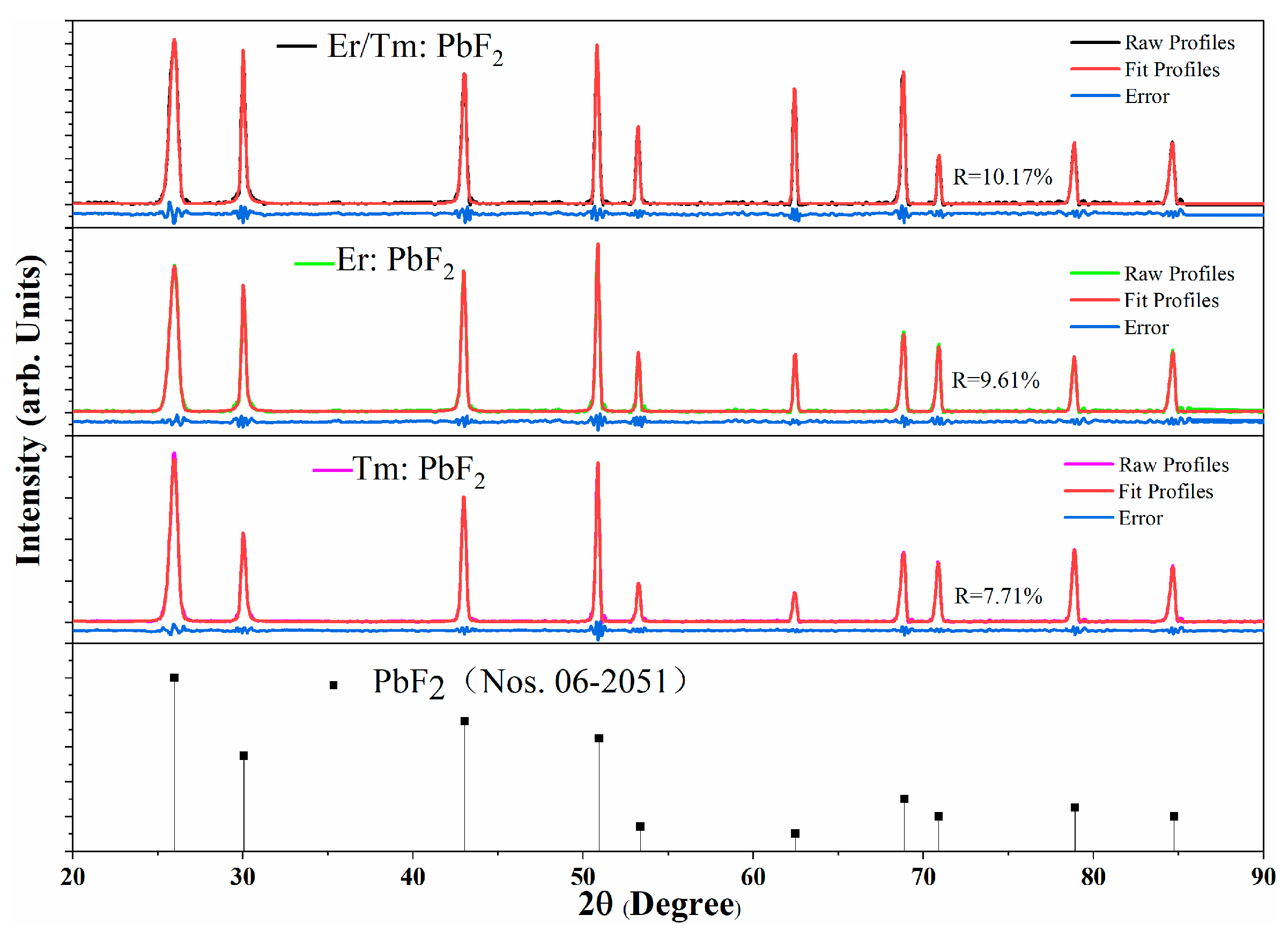
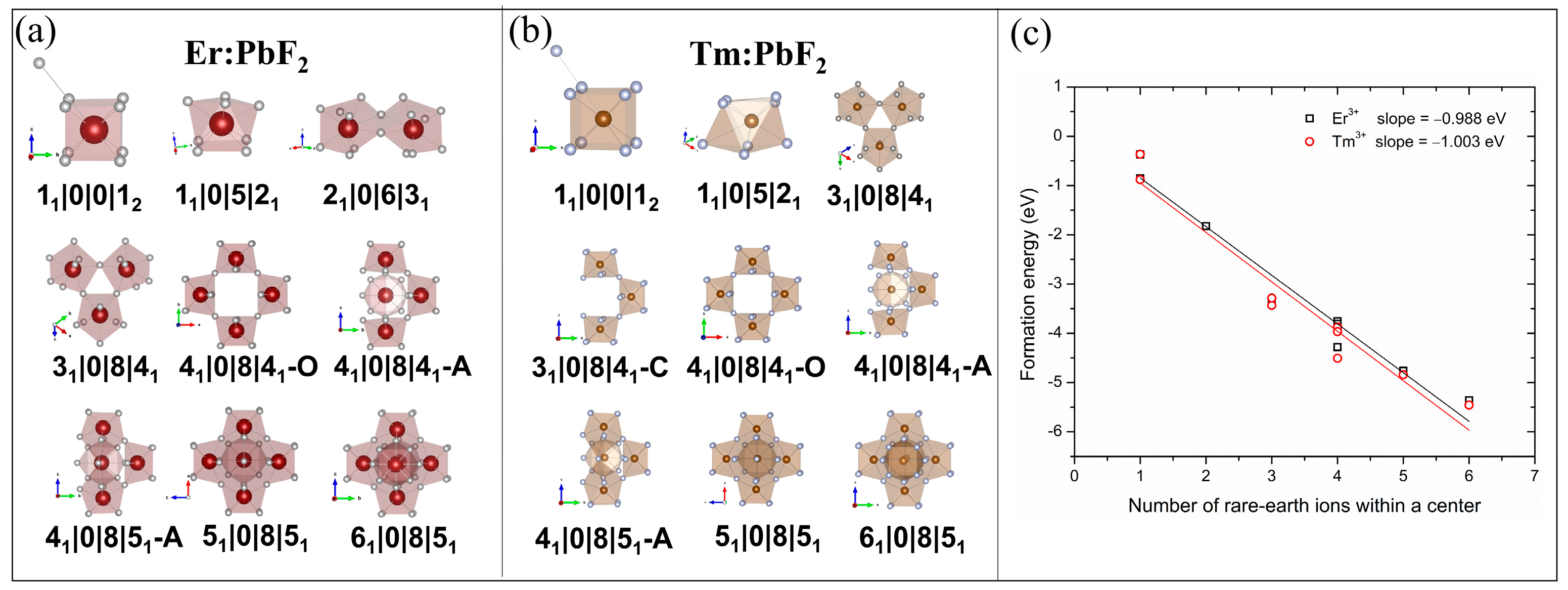
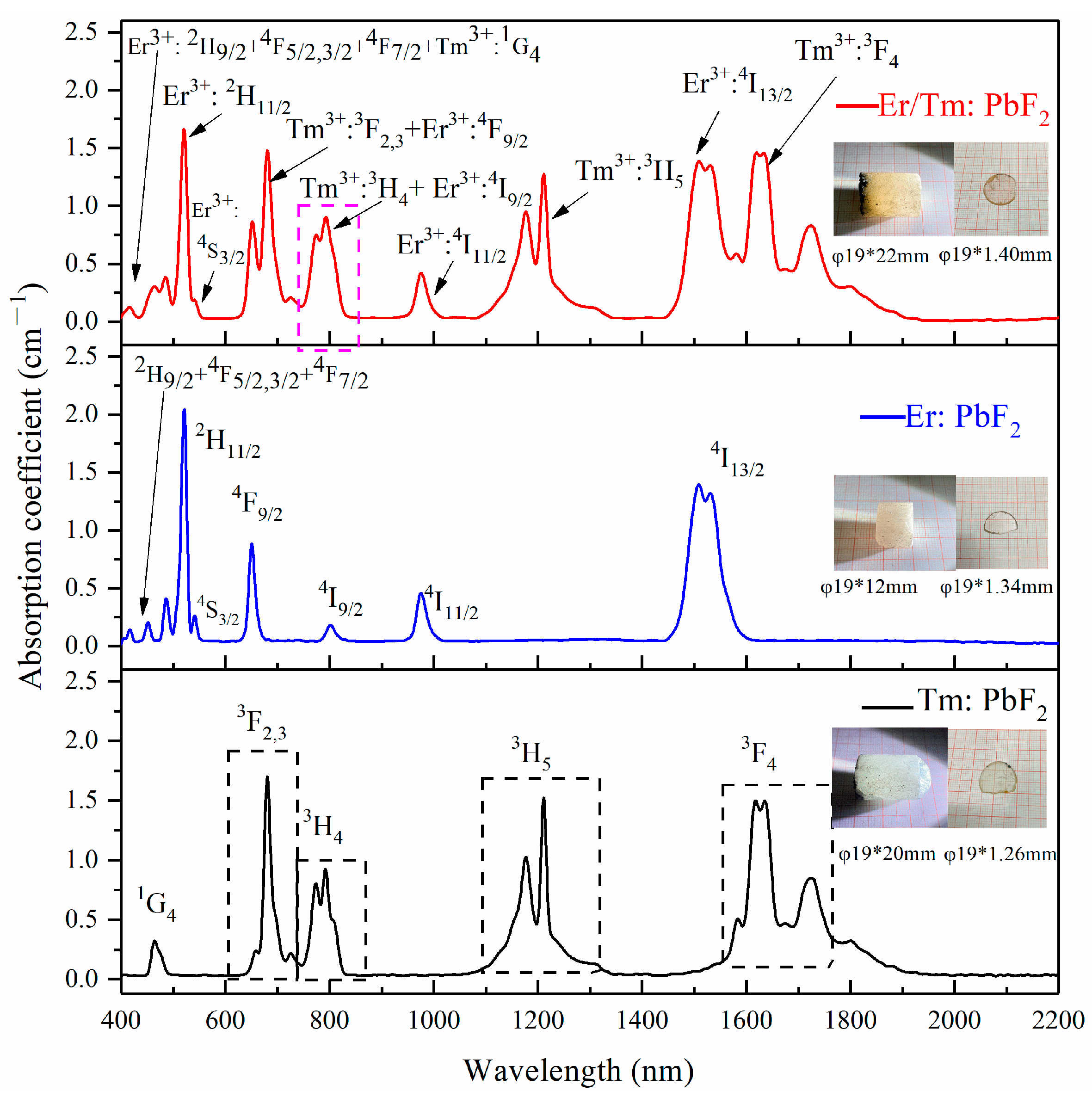
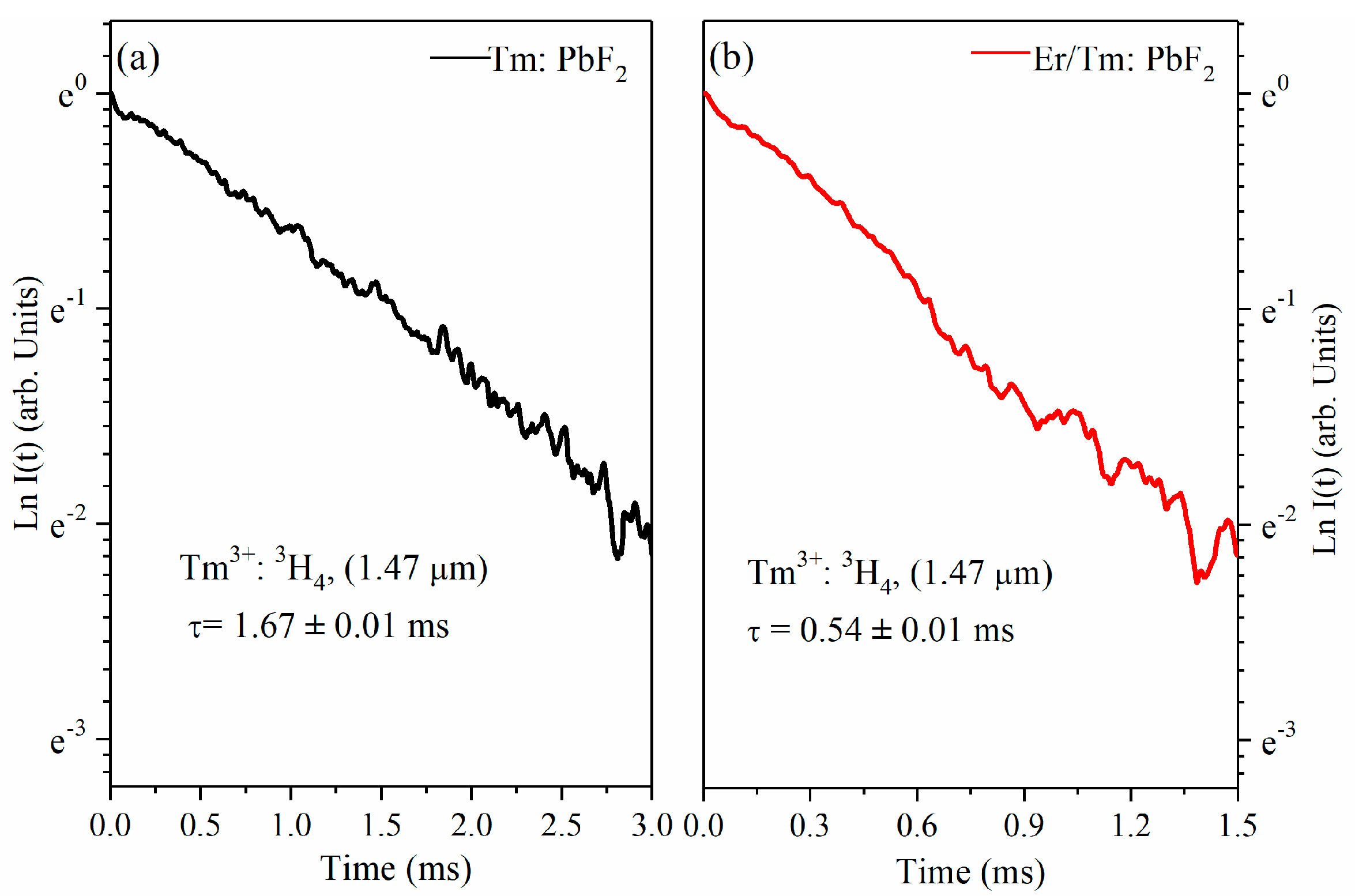
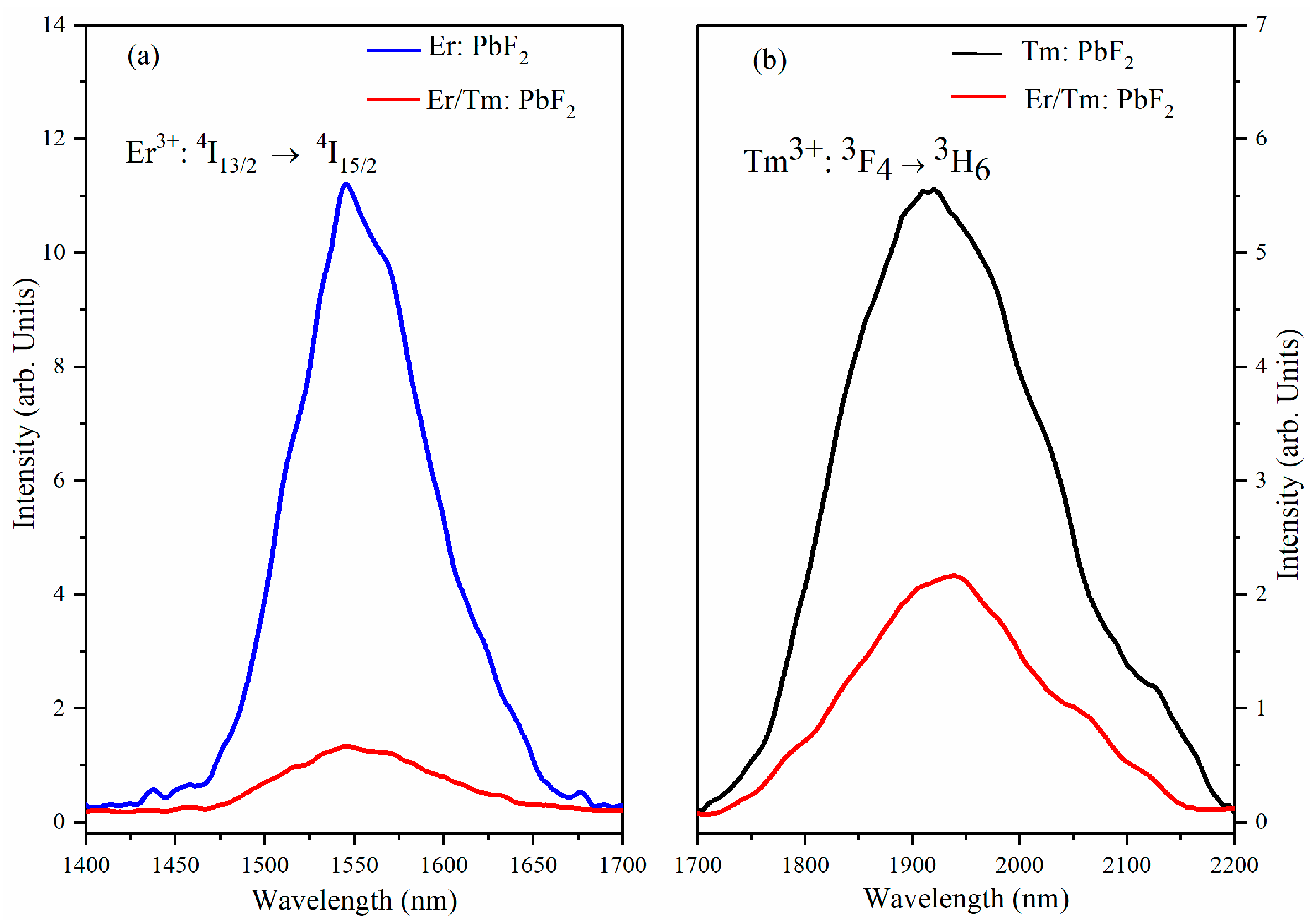
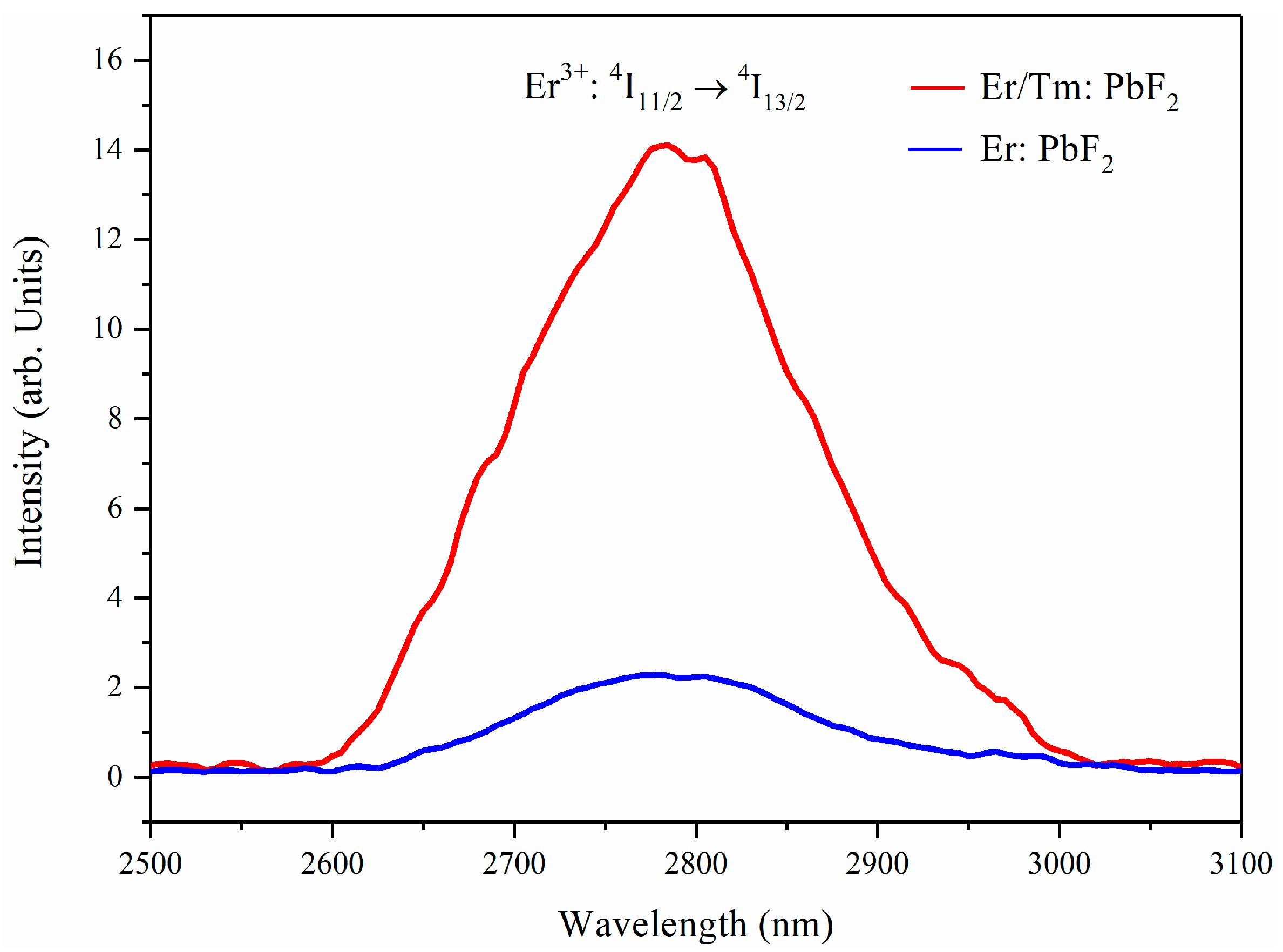

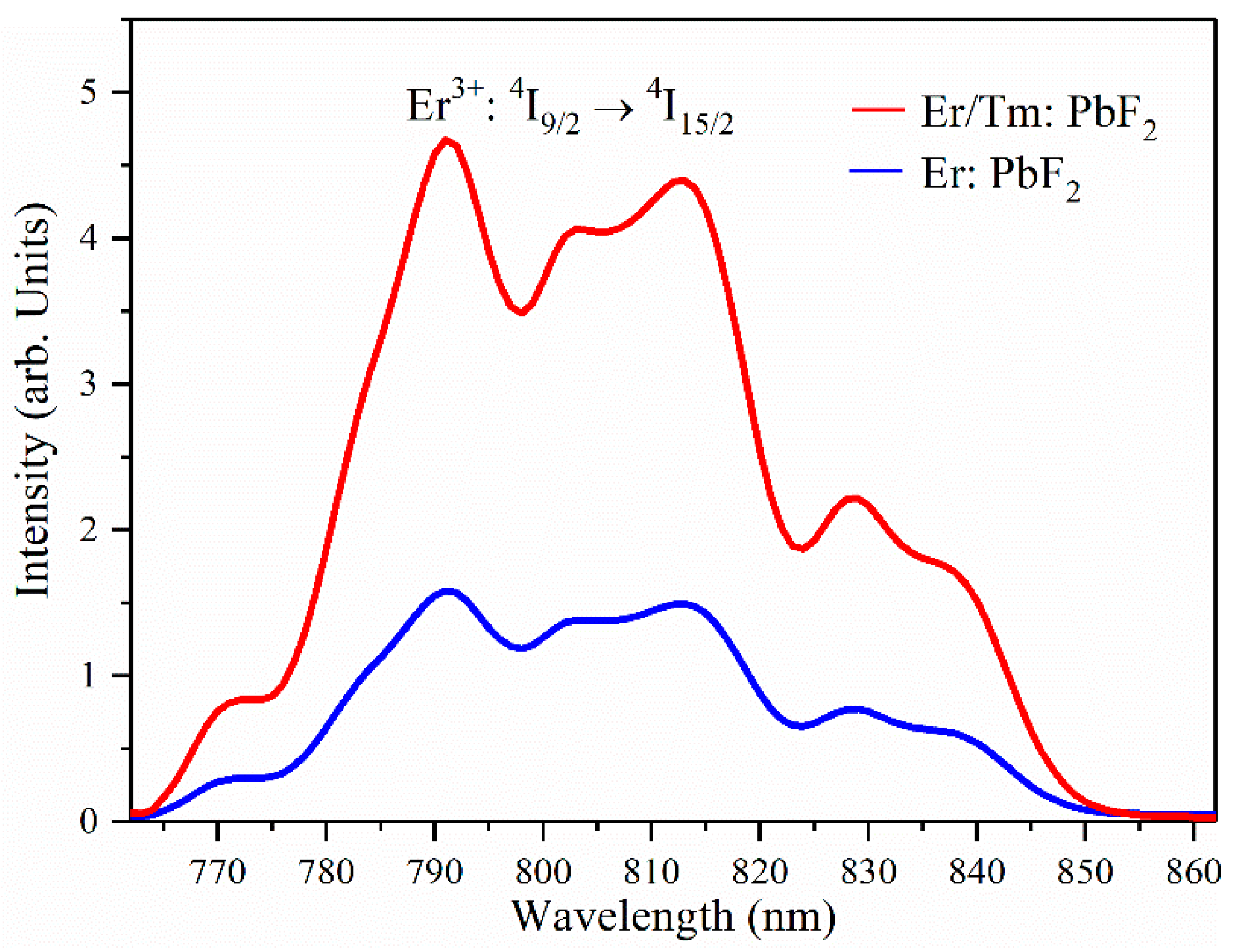
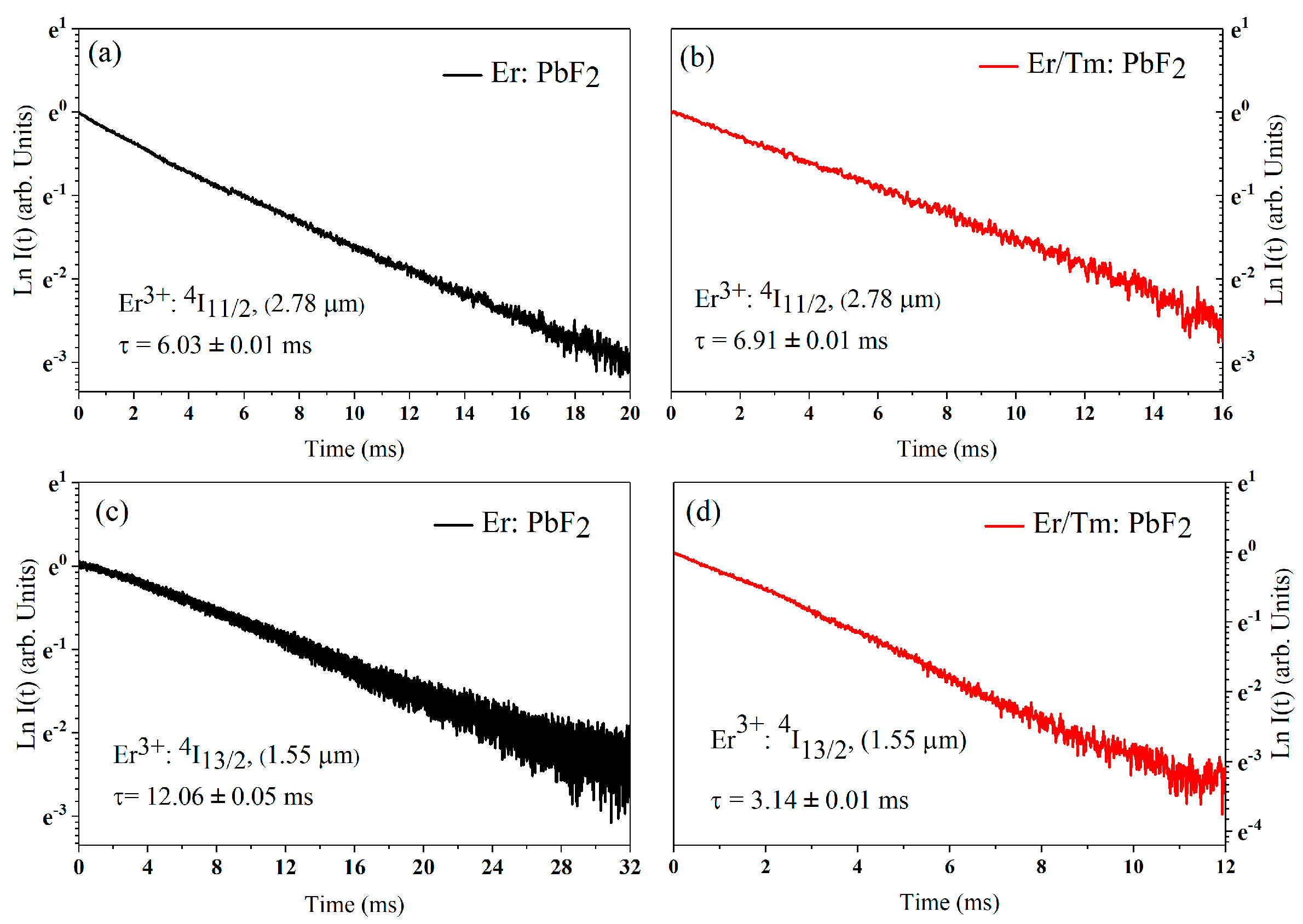
| Crystal | σem | τ(4I11/2) | τ(4I13/2) | τ(4I11/2)/τ(4I13/2) | Ref. |
|---|---|---|---|---|---|
| (10−20 cm2) | (ms) | (ms) | (%) | ||
| 1.0 at.% /0.5 at.% Er/Tm: PbF2 | 0.63@2780nm | 6.91 ± 0.01 | 3.14 ± 0.01 | 220.06 | [This work] |
| 1 at.% Er: PbF2 | 0.32@2780nm | 6.03 ± 0.01 | 12.06 ± 0.05 | 50.00 | [This work] |
| 10 at.% Er:BaLaGa3O7 | 7.34@2714nm | 0.72 | 7.99 | 9.01 | [44] |
| 10 at.% Er:CaLaGa3O7 | 17.9@2702nm | 0.77 | 8.41 | 9.16 | [45] |
| 8 at.%Er:LuAl3(BO3)4 | 8.60@3170nm | 2.10 | 2.54 | 82.68 | [46] |
| 7 at.% Er:Y2O3 | 1.41@2723nm | 2.95 | 17.57 | 16.79 | [47] |
| 10 at.% Er:SrGdGa3O7 | 1.30@2.7μm | 1.10 | 4.48 | 24.55 | [24] |
| 5at.% Er:YAP | 9.00@2792nm | 0.85 | 7.30 | 11.64 | [13] |
| 7 at.% Er:Lu2O3 | 1.10@2730nm | 1.10 | 4.30 | 25.58 | [14] |
| 5 at.% Er:GdScO3 | 0.93@2720nm | 2.24 | 4.57 | 49.02 | [15] |
| 4 at.% Er:SrF2 | 0.78@2727nm | 9.56 | 15.06 | 63.48 | [16] |
| 4 at.% Er:CaF2 | 0.65@2720nm | 5.98 | 9.94 | 60.16 |
Publisher’s Note: MDPI stays neutral with regard to jurisdictional claims in published maps and institutional affiliations. |
© 2021 by the authors. Licensee MDPI, Basel, Switzerland. This article is an open access article distributed under the terms and conditions of the Creative Commons Attribution (CC BY) license (https://creativecommons.org/licenses/by/4.0/).
Share and Cite
Liao, J.; Chen, Q.; Niu, X.; Zhang, P.; Tan, H.; Ma, F.; Li, Z.; Zhu, S.; Hang, Y.; Yang, Q.; et al. Energy Transfer and Cross-Relaxation Induced Efficient 2.78 μm Emission in Er3+/Tm3+: PbF2 mid-Infrared Laser Crystal. Crystals 2021, 11, 1024. https://doi.org/10.3390/cryst11091024
Liao J, Chen Q, Niu X, Zhang P, Tan H, Ma F, Li Z, Zhu S, Hang Y, Yang Q, et al. Energy Transfer and Cross-Relaxation Induced Efficient 2.78 μm Emission in Er3+/Tm3+: PbF2 mid-Infrared Laser Crystal. Crystals. 2021; 11(9):1024. https://doi.org/10.3390/cryst11091024
Chicago/Turabian StyleLiao, Jiayu, Qiudi Chen, Xiaochen Niu, Peixiong Zhang, Huiyu Tan, Fengkai Ma, Zhen Li, Siqi Zhu, Yin Hang, Qiguo Yang, and et al. 2021. "Energy Transfer and Cross-Relaxation Induced Efficient 2.78 μm Emission in Er3+/Tm3+: PbF2 mid-Infrared Laser Crystal" Crystals 11, no. 9: 1024. https://doi.org/10.3390/cryst11091024
APA StyleLiao, J., Chen, Q., Niu, X., Zhang, P., Tan, H., Ma, F., Li, Z., Zhu, S., Hang, Y., Yang, Q., & Chen, Z. (2021). Energy Transfer and Cross-Relaxation Induced Efficient 2.78 μm Emission in Er3+/Tm3+: PbF2 mid-Infrared Laser Crystal. Crystals, 11(9), 1024. https://doi.org/10.3390/cryst11091024





